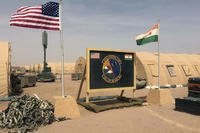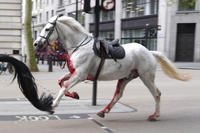The body of terrorist mastermind Osama bin Laden was cast into the waters of the North Arabian Sea early Monday from the deck of the aircraft carrier USS Carl Vinson, senior defense officials announced, after it was prepared according to traditional Islamic practices and a brief service was read and translated into Arabic.
Handlers aboard the Carl Vinson – officials did not specify whether they were U.S. Navy sailors – began preparing bin Laden’s body at 1:10 a.m. Monday, and finished at 2 a.m.: It was washed and placed in a white sheet, which was then placed in a weighted bag. A military officer read prepared religious remarks, which were translated into Arabic by a native speaker, and then Bin Laden’s body was tipped into the ocean.
Bin Laden was buried at sea because Islamic practice dictates the dead be buried within 24 hours, and American officials could find no country that was willing to accept the body, a senior defense official said.
Senior defense and intelligence officials briefed reporters Monday at the Pentagon about bin Laden’s fate, the operation in which he was killed, and the years of work that led up to it. No single tipoff or source led to the operation Sunday in which U.S. special operators attacked bin Laden’s secret compound, the officials said, instead pieces of information came from terrorist detainees; satellite observation; and many other origins.
“This should send a signal to every member of Al Qaeda and every affiliate not only of U.S. resolve, but U.S. capability – to bring those who have killed Americans, or other innocents, of our ability to bring them to justice,” one senior defense official said.
American military and intelligence officials confirmed that they had not shared any information about bin Laden’s compound or their plans for an assault with any ally, including Pakistan. When the team of special operators that conducted Sunday’s operation had returned to their base, Washington began to notify Pakistani officials and other allies about what had happened.
The senior officials, eager to use the death of bin Laden to help repair America’s damaged relationship with Pakistan, said that Pakistanis were among the sources that had helped build the picture of bin Laden’s compound.
Four “military-age men,” including bin Laden, lived in the walled compound, the officials said, along with several women and children. Bin Laden and his family lived on the second and third floors of a main building, and the other people lived on the first floor and in another structure inside its triangular, 18-foot high walls. The special operations team was in the compound for about 40 minutes, the officials said, and they were engaged with occupants almost the entire time, either in firefights or as they explored and cleared its buildings and rooms.
Bin Laden was killed "toward the end" of the 40 minutes, a senior defense official said. Although the Pentagon officials would not describe his final moments or last words, they made it sound as though he was hiding with at least one woman on the second or third floor of his residence. Although the officials said men in the compound were using women "as shields," they would not go into further detail.
The senior officials would not comment Monday about reports that said American special operators had built a mock compound beforehand where they practiced their assault. They would not confirm the special operators were U.S. Navy SEALs generally, or specifically whether they came from the elite Special Warfare Development Group. They also would not identify what kind of helicopter crashed during the operation, why it crashed, or identify any of the helicopters that were involved. Press speculation has had it that they could have included Black Hawks, CH-47 Chinooks or MH-6 Little Birds.
One detail officials did clarify was that the special operators who destroyed the crashed helicopter evidently did so themselves, with their own explosives: As they prepared to leave, the team moved surviving locals in the compound safely away from the crash site and then blew up their broken helo.
A senior intelligence official confirmed the special operators brought back "a robust collection of materials that we need to sift through -- we hope to find valuable intelligence that will lead us to other players in Al Qaeda.”








